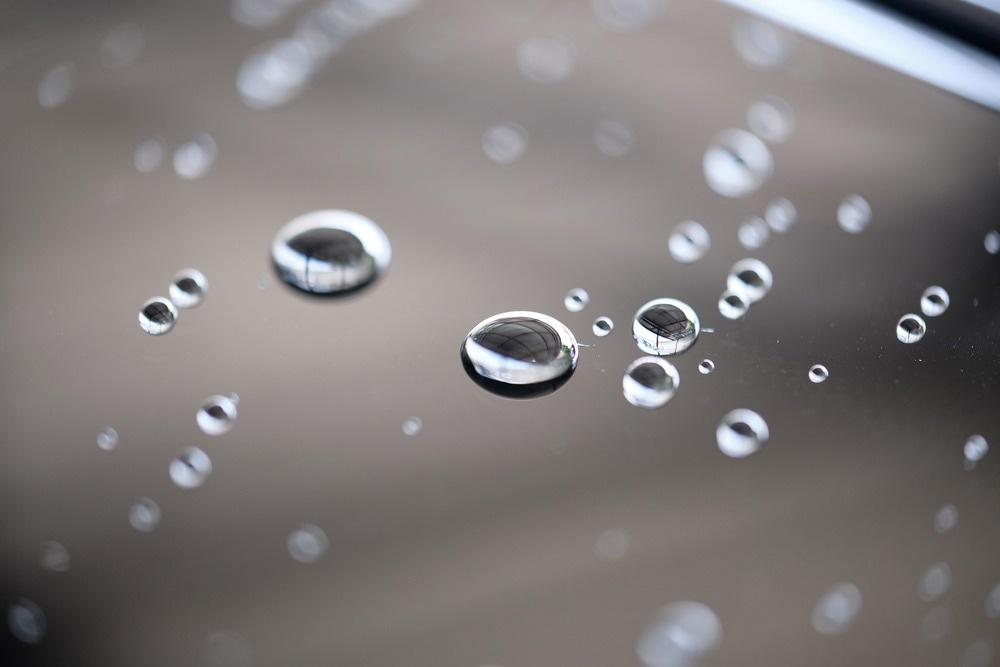Self-healing coatings have great applicability and promise in metal corrosion prevention applications due to their excellent performance. In a paper published in the journal ACS Applied Materials & Interfaces, a self-healing superhydrophobic coating was developed.

Study: Robust Self-Healing Graphene Oxide-Based Superhydrophobic Coatings for Efficient Corrosion Protection of Magnesium Alloys. Image Credit: KULLAPONG PARCHERAT/Shutterstock.com
Here researchers mixed polydopamine-functionalized, Cu2+-loaded graphene oxide, polydimethylsiloxane, and octadecylamine, which can restore the coating's superhydrophobic characteristics after physical or chemical degradation.
Advantages and Limitations of Superhydrophobic Coatings
Superhydrophobic coatings have become increasingly appealing because of their wide range of applications. This includes sensing devices, the biomedical sector, and maritime coatings, especially to prevent corrosion.
Several processing approaches have been employed in past years to create superhydrophobic coatings with a reduced surface-energy layer and coarse microscale/nanoscale architecture. When superhydrophobic coatings come into direct contact with water, the coarse surface traps air and forms a stabilized protecting layer.
Superhydrophobic coatings have emerged as an excellent choice for coating metals for corrosion prevention because of their unique properties. Nonetheless, owing to their sensitive microscale/nanoscale hierarchical architectures, superhydrophobic coatings are prone to losing their superhydrophobic behavior after chemical or physical degradation, severely limiting their use in realistic conditions.
It is therefore critical to develop strong superhydrophobic coatings with self-recoating capabilities.
Preserving Superhydrophobic Coatings via Self-Healing
Based on the intrinsic capacity of creatures to heal themselves, researchers have investigated self-recoating composites that may partially or entirely regain their integral properties after damage.
In contrast to standard protective coatings, a self-recoating layer may regain hydrophilicity by applying heat to the chemically injured surface. Nonetheless, documented self-recoating superhydrophobic coatings have several flaws, such as complicated microstructure healing, reduced self-recovery cycling, and failure to self-heal during usage.
To address these issues, the development of smart self-recoating coatings with specialized functionalities has piqued the attention of scientists from a wide range of industrial domains. As a result, one viable option is to embed the recovery agent in the substrate, such as metallo-organic frameworks, silica, and graphene oxide (GO), permitting regulated delivery of the active ingredient to the defected region of the coating.
Overcoming Limitations of Self-Healing by Using GO Frameworks
GO is obtained from graphitic powder following an oxidation process and exfoliating, and it has a considerable amount of carboxyl, epoxide, and hydroxyl functional groups. GO has garnered considerable interest due to its unique qualities, including outstanding mechanical/chemical stability, a huge contact area, and ideal barrier effectiveness against hostile species.
Unfortunately, GO is susceptible to galvanic corrosion reactions with metallic substrates, potentially leading to severe corrosion. Biopolymers like polydopamine (PDA) may help to prevent galvanic corrosion and fix GO faults.
Combing the Effects of Polydopamine and GO
PDA has emerged as a flexible chemical enhancer with a good attachment to various substrates due to hydrogen bonding between amine and catechol. This affinity can recompense GO faults via bond interactions and heal deteriorated regions via chelation with metallic ions.
Due to its high light-absorbing capacity, PDA may also be utilized to create photothermal self-recoating superhydrophobic coatings. Integrating PDA and GO to create self-recoating anticorrosive coatings with distinct functionality is a promising and practical method.
Main Findings of the Study
In this research, the team created a strong self-healing coating with superhydrophobic capabilities out of PDMS, polyamide resin, epoxy resin, and the developed ODA/PDA/rGOCu2+ particles.
After physical or chemical damage, the POPG-Cu2+ coating may concurrently repair its compromised microscopic architecture and recover its superhydrophobic characteristics. When the coating is broken, the microscopic architectures could be automatically healed using dynamic catechol-Cu2+ interaction, and its superhydrophobic characteristics could be promptly regenerated using sunlight to rearrange ODA/PDMS.
Even after undergoing 20 rounds of plasma etching/healing, the developed POPG-Cu2+ coatings maintained superhydrophobic capabilities when exposed to sunlight. The self-recoating ability was a result of ODA/PDMS molecular reorganization and dynamic catechol-Cu2+ interactions.
The POPG-Cu2+ coating demonstrated exceptional self-cleaning and anti-fouling qualities. In addition, the POPG-Cu2+ coating demonstrated good mechanical durability, chemical endurance, and weather tolerance. Notably, after one month in a 3.5 w% sodium chloride solution, the POPG-Cu2+ coating maintained remarkable anticorrosive performance.
The findings of this study give practical direction for developing superhydrophobic coatings with long-lasting anticorrosive properties and excellent self-recoating capabilities.
Reference
Li, B., Xue, S., Mu, P., & Li, J. (2022). Robust Self-Healing Graphene Oxide-Based Superhydrophobic Coatings for Efficient Corrosion Protection of Magnesium Alloys. ACS Applied Materials & Interfaces. Available at: https://doi.org/10.1021/acsami.2c06447
Disclaimer: The views expressed here are those of the author expressed in their private capacity and do not necessarily represent the views of AZoM.com Limited T/A AZoNetwork the owner and operator of this website. This disclaimer forms part of the Terms and conditions of use of this website.